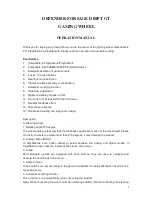
GB
I
D
7
Per utilizzare il sincronismo è necessario:
inserire il jumper sulla coppia di “pin”
esistente sulle schede (trasmettitore e
ricevitore) delle fotocellule (fig. 7), tale
operazione va fatta su entrambe le
coppie di fotocellule;
eseguire il collegamento dei cavi come
descritto in fig. 6.
Indichiamo con N e B i due cavi di
alimentazione.
Nello schema si è considerata una
alimentazione a 24 Vac; per un funzionamento
a 12 Vac utilizzare i morsetti 1 e 2 anziché 1
e 3.
Se l’installazione prevede 3 coppie di
fotocellule, la terza coppia deve essere
collegata come la coppia più lontana.
COLLAUDO
Il collaudo dell’automazione deve
essere eseguito da una PERSONA
COMPETENTE diretta e controllata da
un INSTALLATORE PROFESSIONALE.
Per ogni dispositivo delle fotocellule
installato eseguire le seguenti verifiche
secondo le morme
EN 12445
e
EN 12453
:
a) Verificare che non vi siano
interferenze con altri dispositivi.
b) Dalla centrale di comando togliere
l’alimentazione alle fotocellule e
verificare lo stato d’ALLARME.
c) Alimentare solo il ricevitore e
verificare lo stato d’ALLARME.
d) Alimentare anche il trasmettitore e
verificare lo stato ATTIVO.
e) Passare un tubo cilindrico del
diametro di 5 cm e della lunghezza di
30 cm attraverso l’asse ottico che
collega le due fotocellule. Eseguire la
prova come prima vicino al
trasmettitore, poi vicino al ricevitore
e infine nella mezzeria tra le due.
ATTENZIONE: una volta collaudata
l’automazione NON devono essere più
modificati i parametri impostati. In caso di
eventuali variazioni delle regolazioni (es.
modifica del valore di tensione), devono
essere rieseguite tutte le verifiche previste
nel collaudo e dalla norma EN 12445.
MANUTENZIONE
Le fotocellule non hanno necessità particolari,
ma è necessaria una manutenzione
programmata almeno ogni 6 mesi nella quale:
Disconettere l’alimentazione
dell’automazione prima di effettuare
operazini di manutenzione o pulizia.
eseguire la pulizia dell’involucro esterno
e delle lenti, e rieseguito il collaudo come
descritto al cap. COLLAUDO.
Esaminare frequentemente l’installazione
per verificare che non ci siano segni di
usura e segni di danneggiamento.
SMALTIMENTO
La fotocellula è costruita con vari materiali
il che implica modalità di smaltimento
diverse. Fare riferimento alle norme
vigenti nel paese in cui è installata.
Fare eseguire lo smantellamento da
personale qualificato.
In order to use synchronisation it is
necessary:
to insert the jumper on the pair of pins
on the cards (transmitter and receiver)
of the photocells (fig. 7), this operation
must be conducted on both pairs of
photocell;
perform cable connection as described
in fig. 6.
N and B have been used to indicate the two
power supply cables.
The diagram refers to a 24 Vac power supply;
for 12 Vac operation use terminals 1 and 2
rather than 1 and 3.
If the intervention includes 3 pairs of photocell,
the third pair must be connected in the same
way as the farthest pair.
TESTING
The operator must be tested by a
COMPETENT PERSON directed and
supervised by a PROFESSIONAL
FITTER.
Under EN standards
12445
and
12453
,
the following checks must be conducted
on each photocell device installed:
a) Check that there is no interference
with other devices.
b) Switch off the power supply to the
photocells from the control unit and
check the ALARM status.
c) Switch the power supply on to the
receiver only and check the ALARM
status.
d) Switch on the power supply to the
transmitter and check the ACTIVE
status.
e) Pass a cylindrical tube with a
diameter of 5cm and a length of 30
cm through the optic axis that
connects the two photocells. Perform
the check first close to the transmitter,
then close to the receiver and lastly
halfway between the two.
ATTENTION: once the automation has
been tested, the parameters set must not
be altered. If further adjustments (e.g.
alterations to the voltage value) are made,
all the checks required for testing and
compliance with EN standard 12445 must
be repeated.
MAINTENANCE
The photocells do not require any particular
treatment, however routine maintenance must
be conducted at least once every six months,
in which the User must:
Disconnect the operator’s power supply
before performing cleaning or
maintenance operations.
Clean the outer casing and the lenses and
repeat the tests as described in the
TESTING chapter.
Frequently inspect the installation in order
to verify that there are no signs of wear
or damage
DISPOSAL
Photocells are manufactured using a
variety of materials, which implies
different disposal procedures. Refer to the
regulations in force in the country in which
the device is installed.
Contact qualified persons for disposal.
Zur Anwendung der Synchronisierung ist es
erforderlich:
den Jumper auf dem auf den Platinen
(Sender und Empfänger) der
Lichtschranken vorhandenen Pin-Paar
einzufügen (Fig. 7). Dieser Arbeitsschritt
ist für beide Lichtschrankenpaare
auszuführen.
die Kabel gemäss Fig. 6 anzuschließen.
Die zwei Stromkabel werden mit N und B
bezeichnet.
Der Schaltplan bezieht sich auf eine 24-V-
Stromversorgung. Bei einer 12-V-Stromversorgung
sind die Klemmen 1 und 2 anstelle der Klemmen
1 und 3 zu verwenden.
Wenn die Installation 3 Lichtschrankenpaare
vorsieht, ist das dritte Paar als das entfernteste
Paar anzuschließen.
PROBELAUF
Der Probelauf des Antriebs muss von einer
SACHKUNDIGEN PERSON durchgeführt
werden, die von einem
FACHINSTALLATEUR angewiesen und
kontrolliert wird.
Für jede installierte Lichtschrankenvorrichtung
sind gemäss der Richtlinien
EN 12445
und
EN 12453
folgende Überprüfungen
durchzuführen:
a) Überprüfen Sie, dass keine Interferenzen
mit anderen Vorrichtungen bestehen.
b) Unterbrechen Sie die Stromversorgung
der Lichtschranken mittels Steuerung und
überprüfen Sie den ALARMZUSTAND.
c) Speisen Sie nur den Empfänger und
überprüfen Sie den ALARMZUSTAND.
d) Speisen Sie auch den Sender und
überprüfen Sie den
BETRIEBSZUSTAND.
e) Führen Sie einen zylinderförmiger
Schlauch von 5 cm Umfang und einer
Länge von 30 cm durch die optische
Achse, die die zwei Lichtschranken
verbindet. Führen Sie den Test zuerst in
der Nähe des Senders, dann am
Empfänger und zuletzt in der Mitte von
Sender und Empfänger durch.
ACHTUNG: Wenn der Antrieb den Probelauf
bestanden hat, dürfen die eingespeicherten
Parameter nicht mehr verändert werden. Im
Falle von Einstellungsänderungen (z. B.
Änderung des Spannungswerts) sind alle beim
Probelauf und von der Richtlinie EN 12445
vorgesehenen Tests erneut durchzuführen.
WARTUNG
Die Lichtschranken erfordern keine besondere
Wartung, jedoch ist mind. alle 6 Monate eine
regelmäßige Wartung notwendig, bei der folgende
Arbeitsschritte auszuführen sind:
Unterbrechen Sie vor jeder Wartung oder
Reinigung die Stromversorgung des Antriebs.
Reinigen Sie das Außengehäuse und die
Linsen und führen Sie erneut den Probelauf
durch wie in Kap. PROBELAUF angegeben
ist.
Überprüfen Sie die Installation regelmäßig und
vergewissern Sie sich, dass keine Anzeichen
von Abnutzung und Beschädigung vorhanden
sind.
ENTSORGUNG
Die Lichtschranke wurde aus verschiedenen
Materialien hergestellt und erfordert daher
unterschiedliche Entsorgung. Dabei sind die
geltenden Bestimmungen des Landes, in dem
die Lichtschranke installiert wird, zu beachten.
Überlassen Sie die Entsorgung des Antriebs
qualifiziertem Personal.




























